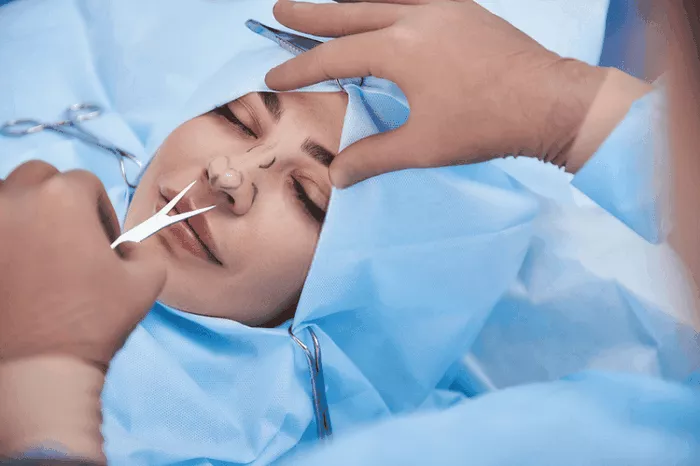Rhinoplasty, also known as nose surgery, is a popular cosmetic procedure that can help to improve the appearance of the nose and correct breathing problems. After rhinoplasty, it is important to follow your surgeon’s instructions to ensure a safe and successful recovery. One common question that patients have is how long to tape their nose after rhinoplasty. In this article, we will explore the answer to this question and provide tips for caring for your nose after rhinoplasty.
What is Rhinoplasty?
Rhinoplasty is a surgical procedure that is used to reshape the nose. It can be used to correct a variety of cosmetic and functional issues, including:
Crooked nose
Hump on the bridge of the nose
Wide or narrow nostrils
Bulbous or drooping tip
Breathing problems
During rhinoplasty, the surgeon will make incisions in the nose to access the underlying bone and cartilage. They will then reshape the nose to achieve the desired look or correct functional issues. After the surgery, the incisions will be closed and a splint or cast may be placed on the nose to help it heal in the proper position.
Taping Your Nose After Rhinoplasty
After rhinoplasty, your surgeon may recommend taping your nose to help support the healing tissues and reduce swelling. Taping can also help to keep the nasal bones in place and prevent them from shifting during the healing process. The length of time that you will need to tape your nose after rhinoplasty will depend on the extent of your surgery and your individual healing process.
In general, most patients will need to tape their nose for about one week after rhinoplasty. This may vary depending on the surgeon’s preference and the patient’s individual needs. Your surgeon will provide specific instructions on when and how to tape your nose based on your individual situation.
How to Tape Your Nose After Rhinoplasty
If your surgeon recommends taping your nose after rhinoplasty, they will provide specific instructions on how to do so. Here are some general guidelines for taping your nose after rhinoplasty:
Clean the skin: Before applying the tape, clean the skin around your nose with a mild soap and water. Make sure the skin is completely dry before applying the tape.
Apply the tape: Cut the tape into small strips and apply them to the bridge of your nose. Make sure the tape is snug but not too tight. The tape should be smooth and free of wrinkles.
Change the tape: You will need to change the tape every day to ensure that it is clean and effective. Gently remove the old tape and clean the skin before applying new tape.
Follow your surgeon’s instructions: Your surgeon will provide specific instructions on how long to tape your nose and when to stop. Follow these instructions carefully to ensure a safe and successful recovery.
Caring for Your Nose After Rhinoplasty
In addition to taping your nose, there are several other things you can do to care for your nose after rhinoplasty. Here are some tips for caring for your nose after rhinoplasty:
Keep your head elevated: Keeping your head elevated can help to reduce swelling and promote healing. Use pillows to prop up your head and keep it elevated while you sleep.
Use cold compresses: Applying cold compresses to your nose can help to reduce swelling and discomfort. Use a clean cloth or ice pack wrapped in a towel and apply it to your nose for 10-15 minutes at a time.
Avoid blowing your nose: Blowing your nose can put pressure on the healing tissues and cause damage. Instead, gently wipe your nose with a tissue or cloth.
Avoid strenuous activity: Strenuous activity can increase blood pressure and cause bleeding. Avoid activities such as running, lifting, or bending over for at least two weeks after rhinoplasty.
Follow your surgeon’s instructions: Your surgeon will provide specific instructions on how to care for your nose after rhinoplasty. Follow these instructions carefully to ensure a safe and successful recovery.
When to See Your Surgeon
If you experience any discomfort or complications after rhinoplasty, it is important to contact your surgeon right away. Some signs that you may need to see your surgeon include:
Severe pain
Bleeding
Fever
Difficulty breathing
Changes in vision or hearing
Worsening swelling or bruising
Your surgeon will be able to assess your symptoms and provide appropriate treatment or advice.
Conclusion
In conclusion, taping your nose after rhinoplasty can help to support the healing tissues and reduce swelling. Most patients will need to tape their nose for about one week after rhinoplasty, but this may vary depending on the extent of the surgery and the individual healing process. Taping your nose after rhinoplasty is a simple process that can be done at home with the guidance of your surgeon. In addition to taping your nose, it is important to care for your nose properly after rhinoplasty by keeping your head elevated, using cold compresses, avoiding blowing your nose, avoiding strenuous activity, and following your surgeon’s instructions. If you experience any discomfort or complications after rhinoplasty, contact your surgeon right away. By following these guidelines, you can ensure a safe and successful recovery after rhinoplasty.

